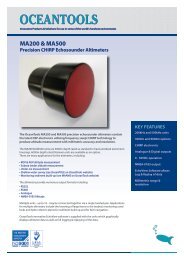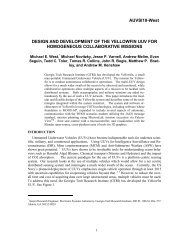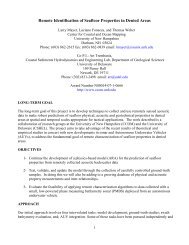Download PDF - AUVAC
Download PDF - AUVAC
Download PDF - AUVAC
Create successful ePaper yourself
Turn your PDF publications into a flip-book with our unique Google optimized e-Paper software.
UAV Autonomy and Swarming Course<br />
Mr John Sauter, Jacobs Technologies<br />
Topics<br />
AFRL, UAS Roadmap, ALFUS, Autonomy Aspects, Autonomy and the OODA Loop, Autonomy and Cooperation (AFRL, Measuring Autonomy,<br />
Control Theory Basics, Feedback Control, Adaptive, Examples of UAS Automation, Aerodynamics and Control, Flight Control. Autopilots, Fault<br />
Recovery, Advanced Adaptive Control, Path Planning, Trajectory Planning, Obstacle/Collision Avoidance, Formation Control, Sensor<br />
Processing, Platform Health Monitoring, Fault Detection, Recovery, Planning Algorithms, Control/Planning Languages, Task Allocation<br />
Algorithms, Scheduling & Coordination Algorithms, Higher Level Sensor Processing Algorithms (GMTI, ATR, target tracking …), General<br />
Optimization Algorithms, Risk Assessment/Management, Manned-Unmanned Coordination, Multi-UAV Control, Formation Control<br />
Algorithms, Intelligence & Autonomy, UAV Swarming, Swarming vs. Multi-UAV Control, Top Down Planning, Bottom Up Emergence,<br />
Surveillance, Multiple Target Tracking, Border Protection, CBRNE Plume Monitoring, Fast Boats, Decoy Swarms, Loitering Munitions, Swarm v.<br />
Swarm, Swarming Algorithms and Swarming UAVs, Boids, Neural Network, Stigmergic, Bottom-Up, Top-Down, Hybrid, Learning and<br />
Adaptation, Design Patterns for Swarming, Defining the Behavioral Rules, Defining the Environment, Evolving and Tuning the Parameters,<br />
Configuring the Swarm, Communicating Intent, Ensuring Performance, Monitoring (what is it doing and why), Limits of Human Control,<br />
Testing Complex Adaptive Systems, Embedded Monitors, Simulation and Testing, Complexity & Emergence, Swarm Intelligence, Swarming<br />
Missions, Swarming Technologies, Example Swarm Design, Human Interaction, Trust & V&V<br />
Subject Matter Expert/Instructor Mr. Sauter is the director of Jacobs Technology’s research group working on novel methods for the<br />
analysis and control of complex adaptive agent-based systems. This group has established an international reputation for its pioneering work<br />
in stigmergic algorithms using fine-grained agent-based systems for unmanned systems. John has over 25 years’ experience in research and<br />
development using fine-grained agent-based methods for modeling and control of complex systems ranging from swarming air vehicle<br />
control to distributed information analytics for massive data. He has led Jacob’s research in swarming unmanned vehicle control over the last<br />
thirteen years. John served as project manager and principal investigator on a number of defense studies and demonstrations of advanced<br />
unmanned systems. He managed the DARPA JFACC program to develop an adaptive air planning application in complex, dynamic threat<br />
environments. He led the OSD NII study to evaluate Jacob’s novel stigmergic swarming algorithms in several full scale simulation<br />
experiments run by the Space and Missile Defense Battle Lab. He led the team that successfully demonstrated the use of swarming<br />
algorithms controlling multiple ground and air vehicles in several tests held at Aberdeen Proving Grounds in 2004 and later at NASA’s Wallops<br />
Island in 2007 and 2009. He has also led projects in studying the effectiveness of swarming unmanned systems for several military<br />
applications including persistent surveillance, target tracking, fast boat surveillance, and perimeter protection. He is the author of over 25<br />
papers and holds three patents using agent-based technologies for the analysis and control of a wide range of systems<br />
(c) 2012 Unmanned Vehicle University<br />
© Unmanned 2012 Unmanned Vehicle Vehicle University University














![Sonardyne Wideband Sub-Mini 6 [8270, 8271].pdf - AUVAC](https://img.yumpu.com/44408971/1/190x245/sonardyne-wideband-sub-mini-6-8270-8271pdf-auvac.jpg?quality=85)


